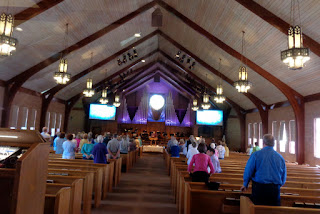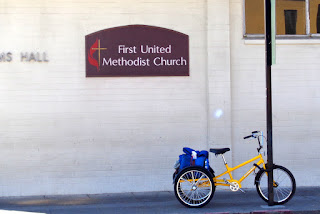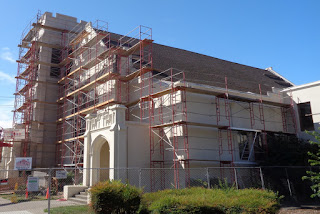This month we're worshiping in
churches of denominations we haven't yet written about. This week we worshiped in a
Seventh Day Adventist Church building, but we already wrote about a visit to a Seventh Day Adventist Church, so before we talk about Sunday's worship,
we'll talk facilities.
On August 24th, 2014, Rev. Lee Neish
was awakened, as many people in the Bay Area were, at three in the morning by a
sizeable earthquake. His house was fine. He had been pastoring in Los Gatos
during the Loma Prieta earthquake in 1989, so he'd already learned to secure
the knick-knacks. But he was curious how the church had held up, so he drove
over to see.
He could see immediately that the
worship service would not be happening in that building that morning. In the
sanctuary, sky was visible between parts of the walls and the ceiling. The
damage was severe. The church would be red-tagged that week, marked unsafe for
entry. He went back home.
The phone rang. A city
supervisor who was scheduled to give an announcement in
worship that morning was calling to apologize. There was an emergency city council
meeting, and he couldn't make it to church. Rev. Neish assured him it wouldn't really be a problem.
Rev. Neish then received a phone
call from the denomination's regional superintendent. She was checking to be
sure everyone was safe and well. She also brought assurance that the church was
covered under the Methodist Church's earthquake insurance. She assured Rev.
Neish that they would support the congregation through the rebuilding project.
 He got one more important phone call
the next day. The pastor from the Napa Seventh Day Adventist Church called to
say that his congregation would like to invite the Methodist Church to worship
on Sundays in their facilities until rebuilding was complete. They offered the
use of their facilities free of charge. (Rev. Neish said every Saturday the
home congregation was quite fastidious about cleaning the church so it would be
ready for the Methodist congregation to worship on Sunday.)
He got one more important phone call
the next day. The pastor from the Napa Seventh Day Adventist Church called to
say that his congregation would like to invite the Methodist Church to worship
on Sundays in their facilities until rebuilding was complete. They offered the
use of their facilities free of charge. (Rev. Neish said every Saturday the
home congregation was quite fastidious about cleaning the church so it would be
ready for the Methodist congregation to worship on Sunday.)
I asked Rev. Neish whether the city
had been supportive of the church during the rebuilding. He assured me that was
the case. Before the earthquake, the church was often the host of the city's
musical events because of their excellent acoustics. The city decided to waive
much of the permitting in the rebuilding process, saving the church tens of
thousands of dollars. They hope to be back in their rebuilt facility by Thanksgiving.
This month, we are looking at a
variety of denominations, but this week we saw an example of how many
congregations meeting at many different times and different places is still One
Church.
 When we arrived at church Sunday
morning, the first worship service was concluding. We heard the organ playing a
hymn. After the benediction, many people went outside for refreshments but many
congregants stayed in the pews for a bit listening to the organ. There were
dozens of people in the first service, but it was certainly an elderly crowd.
When we arrived at church Sunday
morning, the first worship service was concluding. We heard the organ playing a
hymn. After the benediction, many people went outside for refreshments but many
congregants stayed in the pews for a bit listening to the organ. There were
dozens of people in the first service, but it was certainly an elderly crowd. We attended the eleven o'clock
Fusion service that met in the chapel rather than the sanctuary. It was a small
group; we were told the numbers were down since they had moved to the Seventh
Day Adventist facility because many people had walked to the service (the two
buildings are about a mile apart), and because of the diminished numbers common
in summer.
We attended the eleven o'clock
Fusion service that met in the chapel rather than the sanctuary. It was a small
group; we were told the numbers were down since they had moved to the Seventh
Day Adventist facility because many people had walked to the service (the two
buildings are about a mile apart), and because of the diminished numbers common
in summer.
But the people who were there were
involved and enthusiastic in their worship. People were encouraged to stand or
sit as they wished, to use a "God mailbox" in the back of the church
to bring their written requests to God, or to light candles on a table at the
entrance. The table also had a place for monetary donations, since passing the
offering plate isn't part of the Fusion experience.
Both services were going through a
series on challenging theological words. That day's word was "salvation."
The Scripture read was Luke 19:10 from a translation that read, "The human
one came to seek and save those who were lost." (I'm more used to the
"Son of Man" which has more messianic resonance with me.) During this
series, the church is using the analogy of a pitching staff for the preachers,
with an opener named Austin, Rev. Neish serving as the middle relief and Jesse
as the closer.
I was interested on the emphasis on
distinguishing salvation from a "Baptist or Evangelical"
understanding of the term. They focused on salvation as not a single,
individualistic experience, but rather as a holistic, communal journey. We also
enjoyed (and appreciated) the way the congregation felt free to comment during
the sermon, even disagreeing a bit with points the speakers made. The teenaged
boy who ran the overhead (and whose father was one of the morning's
"pitchers") commented several times when he felt an idea needed
clarification.
Mindy and I were happy to journey
with the folks of First Methodist at Napa Community Seventh Day Adventist this Sunday.
-- Dean
Statistics:
Service Length: 1 hour 13
minutes
Sermon Length: opener -- 21
minutes
relief -- 7 minutes
closer -- 7 minutes
Visitor Treatment: There was
a greeting time and an attendance sheet during the worship service. We were
greeted warmly by one woman as we hovered near the snack table between
services.
Our Rough Count: 20
Probable Ushers' Count: 35
Snacks: Between the two
worship services, a canopy tent was set up on the entrance sidewalk with chairs
along one side. Boxes of Starbucks coffee (regular and decaf), a pitcher of ice
water, lemonade mix, cookies and muffins were available (along with an
opportunity to organize another week's snack offerings).
Musicians: keyboard -- woman
electric bass -- man
electric guitar -- man
percussion -- man
electric violin -- woman
vocals -- two women, one girl
Songs: Bless the Lord, O My Soul (10,000 Reasons)
One Thing Remains
Amazing Grace/My Chains are Gone
Miles to place: 45
Total California Miles: 10,796
BONUS!
Four Fun Facts about the United
Methodist Church:
1. Though the movement known as
Methodism dates back to 1736, the United Methodist Church was created in 1968
when The Evangelical United Brethren Church and The Methodist Church joined to
form a new denomination.
2. The primary legislative body of the
denomination is the General Conference, which gathers every four years and works
within the boundaries of the Church Constitution and General Rules.
3. On the umc.org website, four areas
of ministry focus are outlined: engaging in ministry with the poor, improving global
health, developing principled Christian leaders, and creating new and renewed
congregations.
4. Although they're clearly spelled
out, it's difficult to summarize the specific beliefs of The United Methodist
Church, but you can read about them here.
--
Mindy












No comments:
Post a Comment